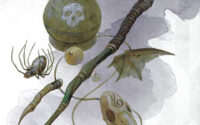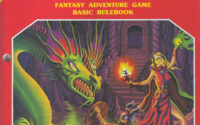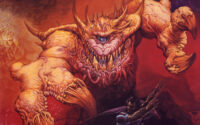Advanced Dungeons & Dragons: Balancing Your Weapons & Equipment
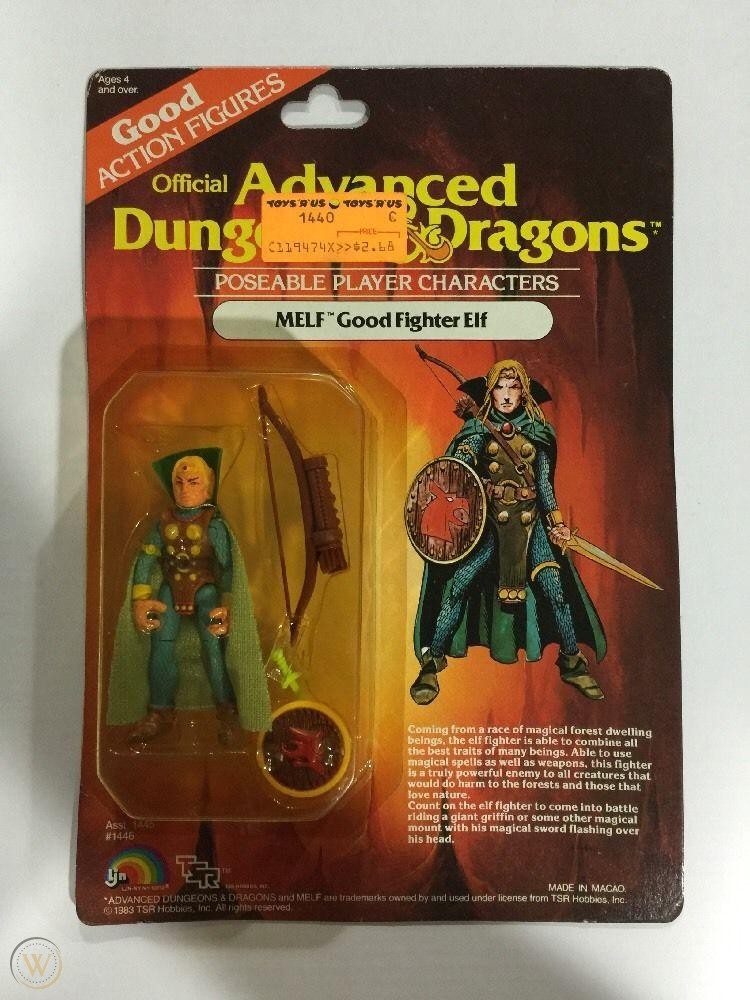
See Spell Level Guide on previous post for Magic-User Spell Level Instructions.
For Dragon Adventures: The Quest For The Golden Arrows , Book One of our Advanced Dungeons & Dragons Campaign Adventure Setting guide book we are only using non-magic user characters in our book guide – however, the Magic Items table will be in place for the game.
Fighters in Advanced Dungeons & Dragons are not allowed using Magic Spells, however they can use Magic Items.
Remember, when equipping your character with Armor and Weapons to also remember to balance your character for future use later in the game when you add Magic Items to your character equipment table.
Later in the game these magic items will allow you to increase you armor class, to hit and saving throw adjustments.
For Fighters in Dragon Adventures Book One write in all 18’s on your character sheet and then calculate your ability score adjustments on your player character sheet.
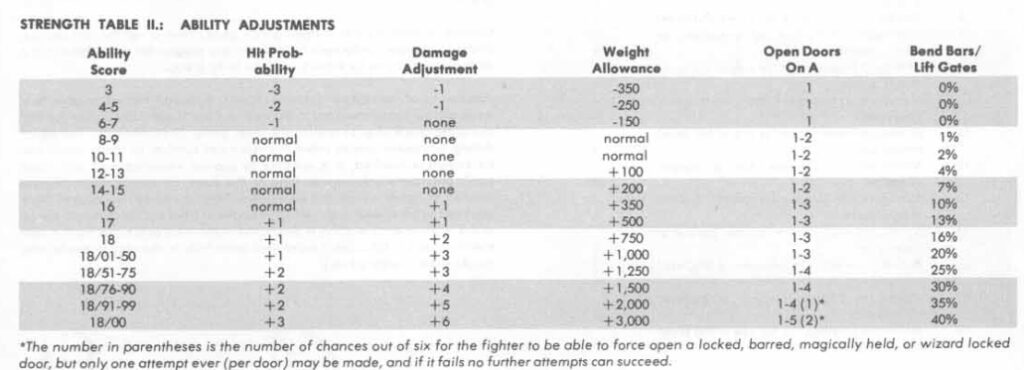
For Ability Score 18 remember to add +3 to your “Hit Probability” and +6 to your “Damage Adjustment”.
During game play, this will add 3 dice points to your “TO HIT ROLL NEEDED” score and also all 6 dice points to “DAMAGE INFLICTED” on your enemy opponent.
Example:
To Hit Roll Needed: Your roll on the dice of 10 for example becomes 13 – meaning a miss dice roll score may become a hit score because to the to hit roll needed adjustment for your strength ability score roll of 18 plus ability score adjustment.
The weapon you use to attack the opponent gains a damage increase of 6 dice roll points increasing the power of your weapon and killing the enemy target in the game faster.
Now you must balance your character, we are using fighter characters so these are non magic score adjustments…for example fighters can wear the strongest armor because they use no spells.
In the game, the concept is Fighters can use the strongest armor and Magic-Users the weakest because the character can’t cast a spell in the “fictional” part of the game in the story if they are wearing armor.
This is to create realism in the game, meaning you have to wear robes to cast spells because you need to hold the magic components on your character wearing the easiest format in the game for quick access to the spell materials.
You can not cast spells in plate mail armor in the game because it is too heavy to be able to access the spell casting materials quickly in the “fictional story” part of the game to create realism.
This is reflected in the armor and weapons adjustment score tables.
This does not make either character weaker or stronger…the Magic-User spells have the same effect as plate mail armor for a fighter, instead of armor it is magic that protects the Magic-User.
Balancing your character at this point will allow your magic items you have later in the game to be more powerful if you adjust the character early in the game properly to allow for maximum character bonus increases for weapons and armor later in the game.
In Advanced Dungeons & Dragons Armor Class is represented as the “LOWEST NUMBER” is the higher armor class meaning the lower the armor class score is the harder it is for the character to be hit during combat in the game.
To balance the character we need to have the lowest armor class and the highest weapon to hit roll needed scores.
So we need to buy armor and weapons for our character that give us the maximum lowest armor class and highest to hit and damage adjustment scores.
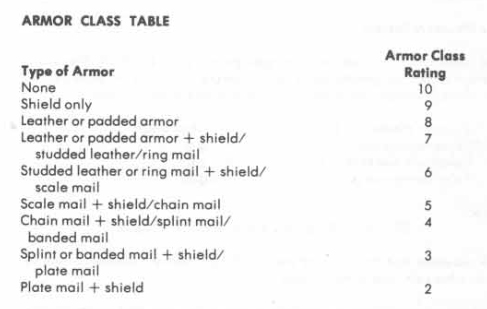
These are your starting Armor Class values in Advanced Dungeons & Dragons.
If you have no armor your starting armor class is 10, if you have plate mail and a shield your starting armor class is 2.
During game play if your character loses their armor your armor class automatically becomes 10 under basic rule conditions.
For our characters in Dragon Adventures: The Quest For The Golden Arrows write in strength 18 and choose plate mail armor and shield which is the strongest armor and write down your starting armor class as 2.
This gives our character a “positive bonus” of starting armor class of 2 – instead of a lower armor class by using something else like leather armor that would give us a starting armor class of 8.
This is how we “maximize” our character to properly balance our game statistics for future use in the game, allowing us to earn more positive bonuses later in the game.
Now we have added our armor we need to add weapons that will increase our damage and to hit roll needed scores.
Now we have to look at the weapons table.
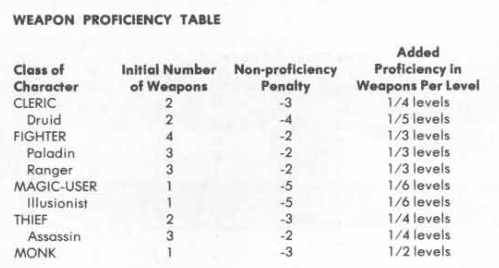
Here is the crucial point where we pick our weapons in Advanced Dungeons & Dragons.
For this example this is only a basic weapons proficiency adjustment score, according to the table above this increases by one point every several levels.
Only use weapons that your character has a proficiency in, using a characters non-proficient weapon will cause a negative penalty to the attack roll instead of positive increase.
Choose a weapons proficiency for your character, this increases as you gain levels.
Choose a weapon that will give you a maximum bonus for your proficiency.
Since we are using fighter characters choose something like the strongest bow and arrow you can get plus sword for your proficiency for The Quest For The Golden Arrows.
Since this is an archery game make the Bow and Arrow your first weapon and the sword second.
Think of weapon proficiency more of a “penalty score” for not using your characters main weapon, on the above table the Fighter Character starts with 4 weapons…since we are making this a simple example just choose those four weapons for your proficiency and then use the the penalty score in the above table if you have to use other weapons during the game to simplify this rule.
Remember, players choose their own weapon proficiency this is not assigned by the game.
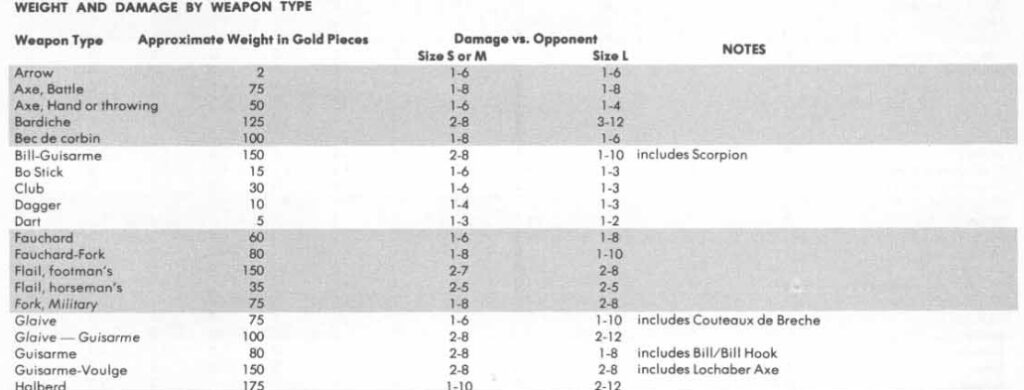
Here is the example, choose a weapon for your character that gives the highest damage to the opponent.
Line one on the above table “arrow” has a 1 – 6 Damage when hitting an opponent for Small, Medium or Large Characters.
REMEMBER: Players Must Keep Track Of These Adjustments! The Dungeon Master will confirm your adjustments during game combat.
Since we are playing The Quest For The Golden Arrows we will be using the bow as our main weapon, and sword as our second.
This will allow us to have maximum damage with our weapon while protecting our character by being able to stand back in the game to fire the arrows instead of close hand to hand sword combat which is more risky for characters instead of a fired weapon which is safer to use in the game.
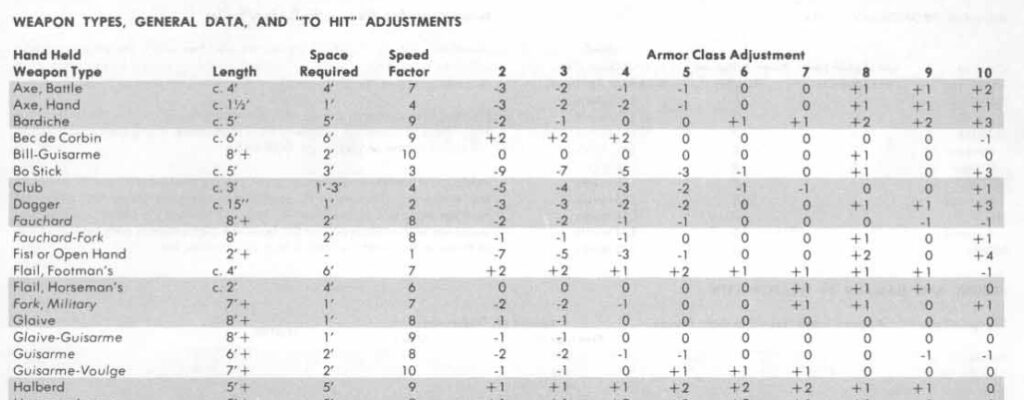
This is somewhat confusing in the game.
Choosing the proper weapon will give your character an armor class adjustment, this can be positive or negative to your character depending on if you use an appropriate weapon to maximize your character.
On line one of the above table in black means character starting armor class.
As you can easily see, this starts at 2…the lowest armor class and means Plate Mail and Shield – the strongest armor which we also picked for our character.
Write your armor class as 2 and then during game play adjust your armor class based on your weapon armor class adjustment.
On line one when you use a Battle Axe this lowers your armor class to -3.
You need to remember this adjustment for each weapon during game play.
Now we need to pick our weapons.
We will start with the bow and arrow.
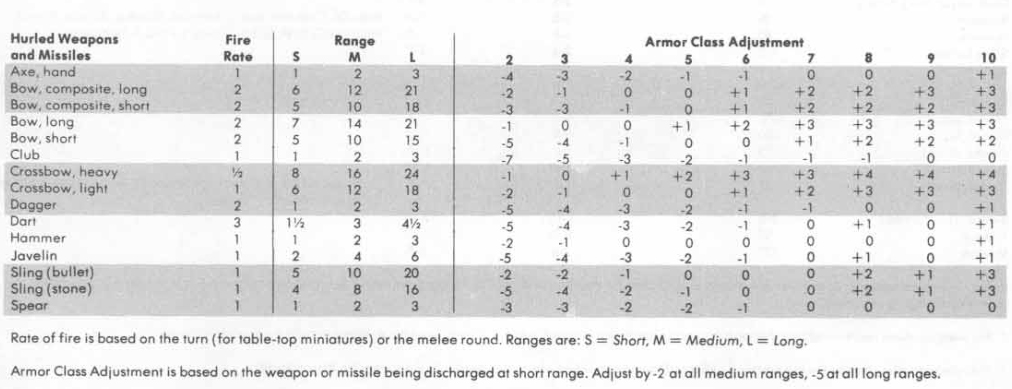
We are going to choose “Bow, Composite, Long” which means “Composite Long Bow”.
You can see under “Fire Rate” that this bow fires Two Arrows per turn at 1- 6 Damage Plus Bonuses.
Using this weapon also lowers your armor class to -2.
Select Plate Mail and Shield armor and Composite Long Bow, this will give you 2 shots per turn with your bow and an armor class score of -2 after your adjustments (starting with armor class 2 before weapon selection).
Now we need to choose a sword weapon.
Back to the hand held weapons table, at the bottom same chart as above with our Battle Axe example but at the bottom of the table.

Choosing short sword will give us an armor class adjustment of -3 (from 2).
You can see this is a balanced fighter character because when you combine the Composite Long Bow with the Short Sword this gives us a an Archer Character with the Maximum Bow and Maximum sword which is the short sword.
Combining these two items together gives you a properly balanced character, giving the character a lower armor class with no penalties.
Our character with an armor class of 2 gets a new armor class of -2 when using a bow and -3 when using a short sword.
HOWEVER, the Composite Long Bow is the primary weapon even though it gives you a lower armor class adjustment than the short sword but it provides two attacks per turn with the short sword only one.
So although the bow gives you a weaker armor class you gain and extra attack per turn.
That is the higher character value.
This guide is only for Armor Class Adjustments for armor and weapon selection.
Remember, your “To Hit Roll Needed” and other “Damage Adjustments” are calculated in a different section in the Advanced Dungeons & Dragons Players Handbook.
PLAY DRAGON ADVENTURES HERE:
http://www.advanceddungeonsanddragons.com/dragonadventures
